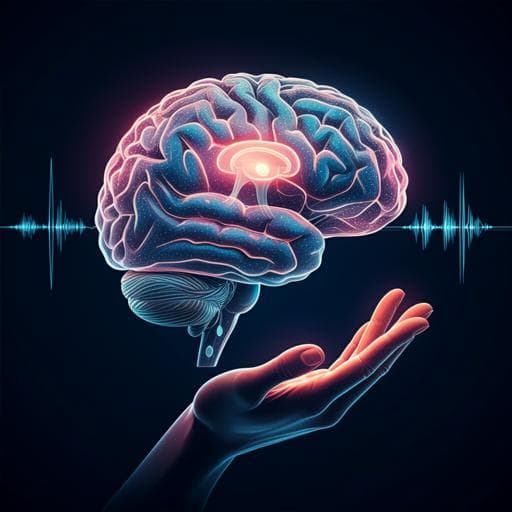
Psychology
Handwriting but not typewriting leads to widespread brain connectivity: a high-density EEG study with implications for the classroom
F. R. (. V. D. Weel and A. L. H. V. D. Meer
This study by F. R. (Ruud) Van der Weel and Audrey L. H. Van der Meer uncovers how handwriting fosters superior brain connectivity compared to typing, particularly enhancing memory and learning. Discover why the scribble of a pen might be more powerful than the click of a keyboard!
~3 min • Beginner • English
Introduction
The paper addresses how the increasing replacement of handwriting by digital devices affects the brain. Prior work suggests handwriting supports spelling accuracy, memory, recall, letter recognition, and understanding. Contemporary neuroscience emphasizes dynamic, distributed functional connectivity across brain networks. High-density EEG can capture millisecond-scale oscillatory dynamics and connectivity relevant to cognition and memory. Building on previous findings that drawing/writing by hand elicits greater brain activation and synchronized theta activity in parietal and central regions than typing, the current study investigates whether handwriting versus typewriting leads to different patterns of functional brain connectivity, particularly in frequency bands (theta/alpha) and regions (parietal/central) implicated in attention, perception, language, sensorimotor integration, and memory formation. The guiding hypothesis is that the act of forming letters by hand engages sensorimotor and perceptual systems to produce stronger, more widespread functional connectivity than typewriting, thereby providing conditions beneficial for learning.
Literature Review
The authors review evidence that handwriting training improves spelling accuracy (Cunningham and Stanovich, 1990), enhances memory and recall (Longcamp et al., 2006; Smoker et al., 2009; Mueller and Oppenheimer, 2014), and facilitates letter/symbol recognition and understanding (Longcamp et al., 2005, 2008; Li and James, 2016). Benefits have been reported for both traditional and digital pens (Osugi et al., 2019). Neuroscience work suggests that complex, precisely coordinated hand movements during handwriting, rather than generic motor activity, are crucial for learning-related neural processes (Pei et al., 2021; Askvik et al., 2020). Functional connectivity—a dynamic, task-dependent coordination across distributed neural circuits—underpins cognition (Lopes da Silva, 1991; Singer, 1993; Bullmore and Sporns, 2009; Edelman and Gally, 2013; Anderson, 2014). Prior EEG research by the authors showed that drawing by hand engages larger brain areas than typing (Van der Meer and Van der Weel, 2017) and that handwriting elicits event-related theta synchronization in parietal and central regions in both children and students (Askvik et al., 2020). Frequency-specific oscillations relate to cognitive processes including memory formation, with theta and alpha bands prominently implicated (Klimesch et al., 1994, 1996, 1999, 2001; Berens and Horner, 2017).
Methodology
Participants: Forty right-handed university students (early 20s) participated; high-quality EEG data from 36 were included. Right-handedness was confirmed using the Edinburgh Handedness Inventory. Participants provided informed consent; the study was approved by regional ethics committees. Compensation was a $15 cinema ticket.
Experimental stimuli and task: Using E-prime 2.0 on a Microsoft Surface Studio, 15 different Pictionary words were each presented twice, yielding 30 randomized trials. In each trial, an instruction ('write' or 'type') preceded word presentation. For 'write' trials, participants wrote the word in cursive with a digital pen on the touchscreen; for 'type' trials, they typed the word repeatedly using the right index finger on a keyboard. Each trial lasted up to 25 s for behavior, but EEG was recorded only during the first 5 s. To reduce gaze-shift artifacts, typed characters were not displayed on the screen during typing. Produced writings were saved for offline review.
EEG acquisition: High-density EEG was recorded using a 256-channel Geodesic Sensor Net (GSN) at 500 Hz with a high-input EGI amplifier.
Procedure: After consent and handedness testing, the appropriately sized EEG net was soaked in saline electrolyte for 15 minutes to optimize conductivity. Participants sat comfortably with the screen and keyboard positioned for ease of use. A pre-test familiarized participants with the task.
Preprocessing and source/connectivity analysis: EEG preprocessing and connectivity analyses were performed with BESA Research 7.0 and BESA Connectivity 1.0. Channels with movement artifacts were removed or interpolated (spherical spline). Up to 10% of channels could be marked bad. Artifact correction used manual and semi-automatic spatial filters. Mean accepted trials (of 15 per condition): handwriting 14.1 (SD=1.1), typewriting 13.3 (SD=1.3). Time-frequency analysis in brain space followed Askvik et al. (2020). Source montages from a multiple source model were used to separate overlapping activities. A 4-shell ellipsoidal head model addressed the inverse problem. Source time series were transformed to the frequency domain via complex demodulation. Functional connectivity between reconstructed sources was computed using coherence, yielding symmetric connectivity matrices (upper/lower triangular symmetry). Frequency range analyzed: 2–60 Hz; epochs from -250 to 4500 ms.
Statistical analyses: BESA Statistics 2.0 computed connectivity measures and identified significant regions. Permutation testing with clustering assessed differences between conditions at each frequency bin (cluster alpha 0.01; 10,000 permutations; Bonferroni correction). Time sampling: 50 ms; frequency sampling: 1 Hz. Significant clusters guided identification of connectivity differences between handwriting and typewriting.
Network measures and visualization: High-resolution functional connectivity matrices were visualized; network measures (hubs, nodes, edges) were extracted to characterize interregional connectivity, focusing on parietal left/mid/right (PL, PM, PR) and central left/mid/right (CL, CM, CR) regions.
Key Findings
- Handwriting elicited far more elaborate and widespread functional connectivity patterns than typewriting, especially in parietal (left, midline, right) and central (left, midline, right) brain regions.
- Positive coherence increases were predominantly in lower frequencies: theta (approximately 3.5–7.5 Hz) and alpha (approximately 8–12.5 Hz). For handwriting, pronounced lower-frequency coherence emerged around 1000–2000 ms post-onset and often persisted throughout the trial window (to 4500 ms), whereas such patterns were weak or absent during typewriting.
- Grand average connectivity matrices showed widespread theta/alpha coherence between PL, PM, PR and CL, CM, CR when writing by hand, but not when typing.
- Statistical testing (permutation tests with clustering) revealed 32 significant cluster differences between handwriting and typewriting, concentrated mainly in parietal and also central regions. P-values for clusters included highly significant effects (e.g., <0.001, <0.005, <0.05). The 32 significant clusters represented 16 significant interregional connections.
- Network analysis identified hubs (≥4 departures/arrivals) and nodes (≤3 departures/arrivals) in parietal and central regions, with theta/alpha edges indicating stronger interregional coupling during handwriting versus typing.
- Connectivity differences spanned frequencies from theta through gamma (up to 60 Hz), but the most prominent and significant differences favoring handwriting were in theta/alpha bands.
- Mean accepted trials demonstrated comparable data quality across conditions (handwriting 14.1/15; typewriting 13.3/15).
Discussion
The findings support the hypothesis that handwriting engages neural systems differently and more extensively than typewriting. Increased theta/alpha connectivity in parietal and central regions during handwriting aligns with mechanisms of sensorimotor integration, attentional control, and memory-related processing. Theta connectivity has been associated with working memory and encoding of novel information, and alpha connectivity with task-specific processing and long-term memory. The observed low-frequency (theta/alpha) synchronization suggests enhanced interregional communication supporting integration of visual, motor, and proprioceptive information inherent to the fine-grained, precisely controlled movements of handwriting. Such low-frequency activity may also interact with higher-frequency oscillations (e.g., theta–gamma coupling), a pattern linked to encoding, retrieval, and episodic memory formation. Collectively, the coherence and network results indicate that handwriting induces functional connectivity patterns that are widely considered beneficial for learning and memory, whereas pressing keys during typewriting does not elicit comparable patterns. These neural differences have direct implications for educational practices, emphasizing the value of handwriting for establishing optimal learning-related brain connectivity.
Conclusion
This study demonstrates that handwriting, compared with typewriting, produces widespread increases in theta/alpha functional connectivity across parietal and central brain regions in young adults, with identifiable hubs and stronger interregional coupling. These connectivity patterns are consistent with neural mechanisms underlying sensorimotor integration and memory formation, suggesting that handwriting provides a neurobiological advantage for learning. Educationally, maintaining and emphasizing handwriting practice—alongside appropriate use of technology—is recommended, with awareness of which modality best supports learning in specific contexts (e.g., note-taking versus essay writing). The authors note that exploring interactions between functional connectivity and local processing (e.g., relationships between theta connectivity and gamma power) may further clarify how handwriting supports cognition.
Limitations
- Participant sample: 36 right-handed university students (young adults), which may limit generalizability to left-handed individuals, children, older adults, or broader populations.
- Motor constraints in typing: Participants typed using only the right index finger to avoid hemispheric crossover effects; this is not representative of typical two-handed typing and may affect the comparability of motor demands between conditions.
- Visual feedback differences: To prevent gaze-shift artifacts, typed characters were not displayed during typing, reducing visual feedback relative to handwriting and potentially influencing neural responses.
- Recording window: EEG data were analyzed only from the first 5 seconds of each 25-second trial, which may not capture later evolving processes.
- Task and stimuli scope: The task involved repeatedly writing or typing single words; results may differ for more complex writing tasks (e.g., sentence or essay composition).
- Indirect inference to learning: The study measured neural connectivity but did not directly assess behavioral learning outcomes within this experiment.
Related Publications
Explore these studies to deepen your understanding of the subject.







